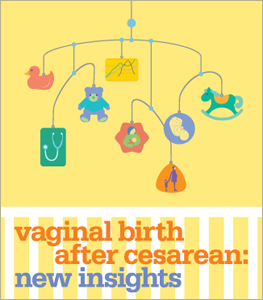Why my first year blogging has changed how I see everything
By: Amy M. Romano, RN,CNM | 0 Comments

As I mentioned the other day, this week is my one-year blogiversary. Like many bloggers, I look back on my first year and realize that I had no idea what I was getting myself into when I clicked 'publish' to submit that first post. I didn't know how much time and mental energy it would take, how strong a sense of community and mutual admiration I would feel with other bloggers, or how many professional doors it would open.
I also had no idea how great the disruptive potential of social media could be. In one year, I have gone from a vague understanding of social media to a deep conviction that, leveraged properly, it represents one of the most potent threats to our dysfunctional maternity care system. I have come to believe that power is up for grabs in our new connected world, and consumers and their advocates are in a better position than ever to seize it.
I'm going to be talking about some of my thoughts on what Web 2.0 means for healthy birth advocacy on ICAN's Radio Show tomorrow. I decided that in preparation for that interview and in honor of my blogiversary, I'd collect some of my favorite experiences from the past year that convinced me that social media may once and for all translate the dissemination of knowledge into better, safer care for women and babies.
 1. For the first time in birth advocacy history, social media played a central role in disseminating the proceedings of scientific meeting with major national and even international significance. Tweets from the conference spread far beyond the choir, and bloggers banded together to write about VBAC as a vital option before the meeting and to break down the panel's recommendations for consumers after the fact. The NIH Panel even gave a 'shout out' to the bloggers, a move that I argued was intriguing if not ground breaking. Susannah Fox from the Pew Internet and American Life Project stopped by the blog to confirm my suspicions that NIH's attention to the blogosphere may be part of a broader awakening of government agencies to what she calls, 'the participatory internet.'
1. For the first time in birth advocacy history, social media played a central role in disseminating the proceedings of scientific meeting with major national and even international significance. Tweets from the conference spread far beyond the choir, and bloggers banded together to write about VBAC as a vital option before the meeting and to break down the panel's recommendations for consumers after the fact. The NIH Panel even gave a 'shout out' to the bloggers, a move that I argued was intriguing if not ground breaking. Susannah Fox from the Pew Internet and American Life Project stopped by the blog to confirm my suspicions that NIH's attention to the blogosphere may be part of a broader awakening of government agencies to what she calls, 'the participatory internet.'
2. I discovered that those of us advocating for better, safer maternity care share much in common with and have a lot to learn from healthcare consumers facing serious illnesses. No, pregnancy and birth are not diseases. But last summer, I discovered The Society for Participatory Medicine, and realized that people facing life-threatening or serious chronic illness have been busy using the internet to shape care in ways the birth community has not yet embraced - but could. In a post titled, Let's Get On This Train: Participatory Medicine and the Future of Maternity Care, I wrote :
Although I had envisioned some pretty nifty things we could do with the internet to improve maternity care, I had my mind pretty well blown recently when I came across a white paper called e-Patients: How They Can Help Heal Healthcare. The paper, the brainchild of a truly visionary doctor, introduces a new web-powered paradigm of healthcare in which patients are empowered, engaged, equipped, and enabled to improve their own health and the quality and safety of the care they receive. It also provides compelling evidence that this new paradigm is already revolutionizing health care in ways we couldn't have envisioned just a decade ago. One of its prominent supporters recently wrote, 'If you have not read the e-Patient White Paper, you do not understand the future of medicine.'
By reading the society's blog, e-Patients.net, and engaging with participatory medicine enthusiasts on Twitter, I learned about sites like Patients Like Me and Cure Together, where people are tracking and sharing their health data online and generating new knowledge about diseases and treatments. I also learned about the movement to put medical records in the control of patients rather than hospitals and doctors, a movement that is gaining serious momentum in Washington. And I even got invited to submit a few guest posts.

3. I saw important research find its way directly into the hands of people who could act on it, skipping the 'middle men' (a.k.a, the years-long process in which university-based research trickles through journals and professional conferences to professionals who can't keep up with every new study and even when they do face cultural or logistical barriers to implementing change in their institutions.) In November I interviewed cord-clamping researcher, Judith Mercer, and comments came in from a medical student, a NICU nurse, a representative of the March of Dimes, several consumers, childbirth educators, and an obstetrician who trains residents. That doctor, Nicholas Fogelson, went on to look at the literature on timing of cord-clamping himself and wrote one of his most widely read and shared blog posts to date, boldly and matter-of-factly titled: Delayed Cord Clamping Should Be Standard Practice in Obstetrics.
4. I had access to people in high places. When the whole country (myself included) was swooning over Atul Gawande's brilliant analysis of health care costs published in the New Yorker, I wrote a post titled The Maternity Conundrum: One Thing Atul Gawande Doesn't Get About Healthcare Reform. It turned out to be the post that would put my blog 'on the map,' and next thing I knew Judy Norsigian from Our Bodies Ourselves emailed it to Atul Gawande, copied me, and I almost fainted. Then a bunch of months later, I left some pretty critical feedback on the blog of a prominent hospital CEO about his handling of a scheduled cesarean broadcast on The Today Show, and he wrote back, and a lengthy conversation ensued. I don't think I've ever had such direct access to influential thinkers, and am sure that I wouldn't have had it not been for good old social media.
5. I spent months reading the published literature on evidence-based care in the second stage of labor for the book I'm writing, only to learn far more by reading the 30+ posts submitted for the Healthy Birth Blog Carnival on pushing. I already had a strong belief that the qualitative literature told a more important story about the harms of conventional obstetric management of second stage than the quantitative literature ever could. What is the blogosphere if not a huge repository of qualitative data? The stories ranged from triumphant to heartbreaking, and collectively made an extremely strong case for physiologic second stage care. The carnival also provided a chance to look comparatively across healthcare specialties. It's not often that critical care nurses weigh in on how things are done on the labor and delivery floor, but in a follow-up post to the Healthy Birth Blog Carnival, blogger and father of four, Man Nurse Diaries, wrote:
Now, I'm not an OB nurse. But in critical care, when you urgently need to give clear commands, ONE PERSON DOES IT, whether you're getting a patient out of bed or coding them. This is so the patient doesn't fall on the floor as three nurses tell them to go three different ways; it's so the code efforts proceed in an orderly fashion; it's so the combative patient has one professional to listen to rather than a room full of hostile voices. But from what I saw, this doesn't happen in obstetrics. It's a free-for-all. The stories in the carnival reflect this; it's really worth covering.
I'm thrilled to have a year of blogging under my belt and to have had this wonderful soapbox thanks to Lamaze International and my wonderful, engaged readers and contributors. But after My Year of Social Media, I'm not all that interested in looking back. I'm facing squarely forward because I think we're in for an interesting ride.
Photo courtesy of merfam via Creative Commons on Flickr.
Published: April 21, 2010
Tags
Social MediaProfessional Resources